
Website founded by
Milan Velimirović
in 2006
12:38 UTC


| |
MatPlus.Net  Forum Forum  General General  Material for a Bristol article Material for a Bristol article |
| |
|
|
|
|
You can only view this page!
| | | (1) Posted by Sarah Hornecker [Saturday, Jun 23, 2007 16:29]; edited by Sarah Hornecker [07-07-10] | Material for a Bristol article
Dear chess friends,
I'd like to write "a few" words about Bristols on my website [July 1: Most probably won't be on my website but in MPR if I ever get it done] Can you please show me some good problems, games and studies with it? I think I'll use other diagrams so there's no real limit (but I think it shouldn't exceed 15 to 20, I could use the rest in a second article there, though).
It shouldn't be a deeply theoretical article like Milan Radoje Vukcevich's famous one [1] I plan something to make OTB players like or understand the bristol. So I'd prefer easy problems with not many black pieces.
I already plan to use [July, 1: not all of these must necessarily make it into the article, I'd like to show only the best but in a manner to make even beginners interested]:
Problem: Frank Healey, Bristol Problem Tourney, 1st prize (1861)
Game: Rosentreter - Höfer, Berlin 1899
Game: Janowski - Lasker, Cambridge Springs 1904
Problem: Ado Kraemer, DSZ 1922
Problem: Jan Hartong, The Western Morning News & Mercury 1922, 1st prize
Problem: Ado Kraemer, DSZ 1936 (?)
Study: FSB, Erevan Ty 1947, 1.hm
Problem: I. Soroka & R. Fedorovich, Schach 1979
Problem: MiVel, StrateGems 2001, 1st prize
Study: Gady Costeff, Die Schwalbe 2001, 1st prize
Also, can you please tell me who composed the following problems?
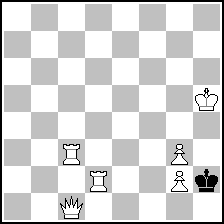 (= 6+1 ) (= 6+1 )
Mate in 2
[July 1st: See below, it was Ado Kraemer]
I don't remember the second but it's alike, on the queenside, and is by a very famous composer (maybe Kraemer/Zepler or "Rätselonkel" Kurt Fabel). It may have been a mate in 3.
[1] http://user.sezampro.yu/~mivel/BRISTOL.HTM
[July 1st and 10th: I updated the posting]
| | | (2) Posted by Hauke Reddmann [Saturday, Jun 23, 2007 18:00]; edited by Hauke Reddmann [07-06-23] |
Gerhard Josten has a few famous Bristols in his oncoming book.
Good that I didn't delete my "lector" files yet... :-)
The study example by Costeff you also mentioned.
Your 2nd "forgotten" is by Ado Kraemer, DSZ 1936
Kc1 Qf3 Rb7 Bd3 Bf4 Bh7 - Kh8, 3#
The diagram *might* be by Speckmann, Frank Richter will
be faster than me anyway digging it up.
Hauke
P.S. Beware of the fine line between Bristol and any Turton-like
combination. One could define: Call it Bristol only if the
stipulation could be fulfilled by waving your magic wand
at the obnoxious figure so it vanishes completely. In this
sense e.g. the Costeff study is no Bristol, since you have to
save the rooks for bad times. If the magic wand makes the piece
only permeable for another - then it is.
You see the subtle difference?
- Healey, Speckmann(?): Rook can be nuked altogether.
- Kraemer, Costeff: Rook may only be neutrino-ed since it is
needed in a side variant.
- Turton-style: Both rooks attack a point, but you must swap
them for whatever reason.
[small EDIT for clarity]
| | | (3) Posted by Sarah Hornecker [Saturday, Jun 23, 2007 18:06]; edited by Sarah Hornecker [07-06-23] |
Dear Hauke, I cite Wikipedia which I think is trustworthy.
QUOTE
Turton doubling is a manoeuvre in chess in which a piece moves along a line (rank, file or diagonal), then a similarly-moving piece moves onto the same line in front of it, then this second piece moves again along this line, in the opposite direction to that of the first. Use of the term is effectively limited to the field of chess problems.
I think Gady's study is a "perpetuum bristol mobile" since both sides do their bristol and then take it back. However, it's not too clear where the borders to a Turton are, there.
QUOTE
Your 2nd "forgotten" is by Ado Kraemer, DSZ 1936
Kc1 Qf3 Rb7 Bd3 Bf4 Bh7 - Kh8, 3#
No! It was something else, much like the #2 I quoted above.
PS: The #2 above is by Ado Kraemer, Deutsche Tageszeitung 1922
http://www.wombat.zaq.ne.jp/propara/diagram/sol04.html
But why do I have to go to a japanese website to find the source for a german problem? We really need a central database...
| | | (4) Posted by Hauke Reddmann [Sunday, Jun 24, 2007 17:51] |
QUOTE
Dear Hauke, I cite Wikipedia which I think is trustworthy.
Not in this case :-E
The *move scheme* of a Turton is correctly described. But it's
the motivation (the "Zweck") that counts in Neudeutsch!
Let's call Q the back, R the front piece and K the attacked object.
Steven Spielberg, your turn!
Q R K
R
Q K
R
QK
RQK
[chomp!]
I must ponder myself if this is a Loyd-, Brunner-, or Zepler-Turton. See:
http://christian.poisson.free.fr/problemesis/themes.html
It might be even done a la mode pericritic, Q doesn't move and R runs
all the way around it. But that entirely misses the point: A Turton
might be in order because the front piece stands in the way, or the
back piece does, but in any case, White *wants* to double.
A Bristol has *always* the front piece in the way, and White doesn't
care at all about doubling or even about the line itself (only about
the field on it). But I reiterate: Even if I have no problems to call
Kraemer No. 2 and Costeff's work a Bristol, there are subtle differences
in the motivation, and you better check your site with an expert (say Rehm)
and then again with another (say Eisert).
QUOTE
But why do I have to go to a japanese website to find the source for a german problem?
Right-o! Japanese Websites [tm] should entirely devoted to bizarre fetishes and
I don't think problem chess is subsumed by that :-)))
Hauke
| | | (5) Posted by Administrator [Sunday, Jun 24, 2007 18:56] |
Siegfried, perhaps you can find few interesting examples for your Bristol article here:
http://www.matplus.org.yu/stosic.htm
| | | (6) Posted by Mihail Croitor [Tuesday, Jun 26, 2007 13:25] |
but how about Bristol, realized by both sides? by example,
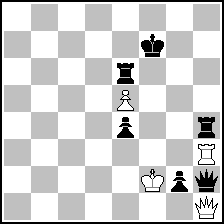 (= 4+6 ) (= 4+6 )
h#2
1.Rh8 Rxh8 2.Qh7 Qxh8#
i cant remember, where i seen double Bristol and my searching dont get me any positive result.
| | | (7) Posted by Neal Turner [Tuesday, Jun 26, 2007 14:21]; edited by Neal Turner [07-06-26] |
This is a double Bristol - but 'realized by both sides'? I think not.
The white rook needs to get to h8 the guard the 8th rank and so the line opening for the black queen is not purely motivated.
The Bristol moves are both black: Rh8, Qh7.
Actually, strictly speaking, shouldn't the Bristol move pass over the square to be occupied, if so then there's no actual Bristol here at all.
| | | (8) Posted by Mihail Croitor [Thursday, Jun 28, 2007 14:56]; edited by Mihail Croitor [07-06-28] |
Interesting explanation, but i want to hear more precise: in Bristol maneuvre first piece cant do additional job, isnt it? And at next position black moves dont illustrate Bristol themу becouse black rook need to take a field near the king anyway?
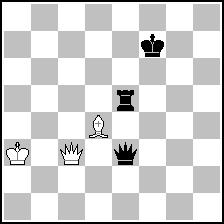 (= 3+3 ) (= 3+3 )
h#2
1. Re8 Bh8 2. Qe6 Qg7#
What about next position?
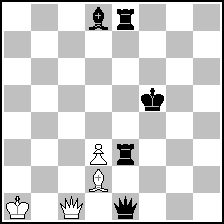 (= 4+5 ) (= 4+5 )
h#2
1. R3e7 Bh6 2. Qe6 Qg5#
| | | (9) Posted by Sarah Hornecker [Friday, Jun 29, 2007 00:19] |
I found the problem I had in mind. Sadly it's not a Bristol but a Brunner Turton. I still like it very much.
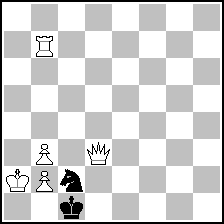 (= 5+2 ) (= 5+2 )
Dr. Erich Zepler
Dr. Palitzsch Memorial Tourney, 1932, 2nd prize
Mate in 4
1.Qd8!! Se1 2.Rd7 Sd3 3.Rxd3 Kc2 4.Rc3 mate
| | | (10) Posted by Arpad Rusz [Sunday, Jul 1, 2007 22:26] |
Could the theme of the following study also be called 'Bristol'? Or at least 'pseudo-Bristol'?
F.Bondarenko
Erevan Ty 1947
1.hm
 (= 4+4 ) (= 4+4 )
win
Solution:
1.a7! [1.Kd1? Kb8 2.a7+ Kb7! 3.Kc1 Ka8 4.Kb1 Kb7 5.Ka1 Ka8 Zz 6.Kb1 Kb7 positional draw] 1...Kb7 2.Kd1 Ka8 3.Kc1 Kb7 4.Kb1 Ka8 5.Ka1! Zz 5...Kb7 6.Qb1+ +-
| | | (11) Posted by Sarah Hornecker [Sunday, Jul 1, 2007 22:36]; edited by Sarah Hornecker [07-07-01] |
I've seen this study some time ago in Harold's database. Yes, this is in my opinion a Bristol and very basic one, indeed. I composed something very alike (but with bishops) and Yochanan Afek (who can be considered an expert) published it as a Bristol in January in The Problemist.
PS: @Michael Croitor - I'll take also bristols where the front piece defends the back piece like...
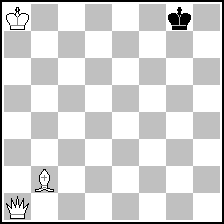 (= 3+1 ) (= 3+1 )
SH, scheme, h#1.5
1...Bh8! 2.Kh7 Qg7#
| |
No more posts |
MatPlus.Net  Forum Forum  General General  Material for a Bristol article Material for a Bristol article |
|
|
|
 ISC 2024
ISC 2024 Forum
Forum  General
General  Material for a Bristol article
Material for a Bristol article 


